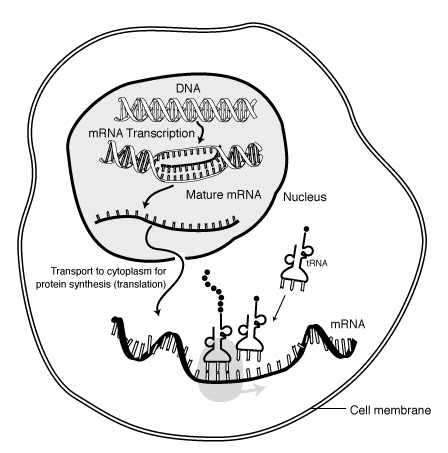
The “life cycle” of an mRNA in a eukaryotic cell. RNA is transcribed in the nucleus; processing, it is transported to the cytoplasm and translated by the ribosome. Finally, the mRNA is degraded. Credit: Public Domain
Messenger RNA (mRNA) made its big leap into the public limelight during the pandemic, thanks to its cornerstone role in several COVID-19 vaccines. But mRNAs, which are genetic sequences that instruct the body to produce proteins, are also being developed as a new class of drugs. For mRNAs to have broad therapeutic uses, however, the molecules will need to last longer in the body than those that make up the COVID vaccines.
Researchers from the Broad Institute of MIT and Harvard and MIT have engineered a new mRNA structure by adding multiple “tails” to the molecules that boosted mRNA activity levels in cells by five to 20 times. The team also showed that their multi-tailed mRNAs lasted two- to three-times longer in animals compared to unmodified mRNA, and when incorporated into a CRISPR gene-editing system, resulted in more efficient gene editing in mice.
The new mRNAs, reported in Nature Biotechnology, could potentially be used to treat diseases that require long-lasting treatments that edit genes or replace faulty proteins.
“The use of mRNA in COVID vaccines is fantastic, which prompted us to explore how we could expand the possible therapeutic applications for mRNA,” said Xiao Wang, senior author of the new paper, a core institute member at the Broad and an assistant professor of chemistry at MIT.
“We’ve shown that non-natural structures can function so much better than naturally occurring ones. This research has given us a lot of confidence in our ability to modify mRNA molecules chemically and topologically.”
“I’m most excited by the fact that this new shape of mRNA is so well tolerated by cellular translation machinery,” said Hongyu Chen, first author of the paper and a graduate student from MIT Chemistry in Wang’s lab. “This opens up many new opportunities for synthetically modifying mRNA to extend its therapeutic uses.”
Staying power
The mRNA in today’s COVID vaccines is so effective because very little is needed—once injected into the body, it stimulates the production of proteins that resemble parts of the COVID virus. “The immune system is very robust, so it’s able to create many antibodies in response to transient expression of a foreign protein,” Chen said.
But for that same type of mRNA to produce enough proteins to treat diseases that disrupt normal production of essential proteins, a much larger dose would be needed, which could cause toxic side effects.
Wang’s lab specializes in understanding how RNA works from the time of its synthesis all the way through to its final degradation and disposal in cells. Wang, Chen, and their team wanted to take on the complex challenge of designing an mRNA structure that could be stable, active, and produce sustained therapeutic effects in low doses.
“I find mRNA very fascinating because as an informational molecule, its function is encoded by its sequence, while its stability is dictated by the chemical properties of its backbone,” Chen said. “This feature gives chemists the versatility to extensively engineer the mRNA structure without worrying about changing the information it carries.”
Based on previous research, Wang and Chen knew that one part of mRNA’s structure, a branch called the poly(A) tail, plays an important role in protecting mRNA from degradation inside cells. In 2022, they showed that chemically modifying the poly(A) tail slows down the natural decay of mRNA, rendering it more useful for a wider range of therapies. They named those modified molecules “mRNA-oligo conjugates” or mocRNAs.
To build on this work, Wang and Chen hypothesized that engineering an even more complex shape of mRNA, containing multiple modified tails of poly(A), would enhance therapeutic effects of mRNA even more.
In their latest effort, the team made their multi-tailed mRNAs, tested them in human cells, and found that they sustained mRNA translation much longer than both natural mRNA and mocRNA, producing up to 20 times more proteins per dose over time.
In mouse experiments, the researchers discovered that just one dose of multi-tailed mRNA led to protein production that lasted as long as 14 days—nearly double the lifetime demonstrated by previous mRNA technologies.
They also used their multi-tailed mRNA to encode the DNA-cutting Cas9 protein as part of the CRISPR-Cas9 gene-editing system and tested that in mice to edit genes linked to high cholesterol, Pcsk9 and Angptl3. They found that just a single dose of multi-tailed Cas9 mRNA could induce higher levels of gene editing, resulting in decreased cholesterol circulating in the bloodstream, compared to animals treated with control Cas9 mRNA.
Wang and Chen are now focused on making their multi-tailed mRNA synthesis and purification process more scalable. They are also taking a closer look at how mRNA modifications affect the interplay between its therapeutic stability and activity.
“We want to see where else we can engineer mRNA’s structure to increase efficiency,” Chen said, adding that they are also interested in modifications that would improve the rate at which cells can scan and translate mRNA’s instructions.
More information:
Branched chemically modified poly(A) tails enhance the translation capacity of mRNA, Nature Biotechnology (2024). DOI: 10.1038/s41587-024-02174-7
Citation:
Messenger RNAs with multiple ‘tails’ could lead to more effective therapeutics, say researchers (2024, March 22)
retrieved 22 March 2024
from https://phys.org/news/2024-03-messenger-rnas-multiple-tails-effective.html
This document is subject to copyright. Apart from any fair dealing for the purpose of private study or research, no
part may be reproduced without the written permission. The content is provided for information purposes only.
>>> Read full article>>>
Copyright for syndicated content belongs to the linked Source : Phys.org – https://phys.org/news/2024-03-messenger-rnas-multiple-tails-effective.html
